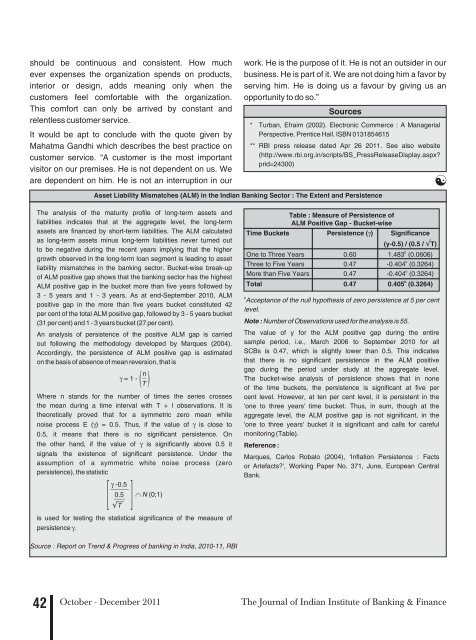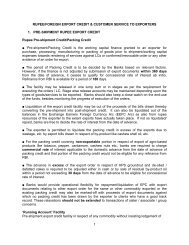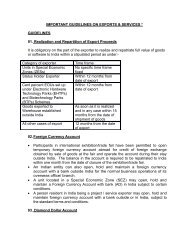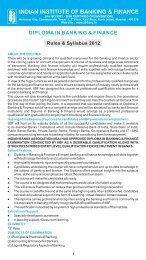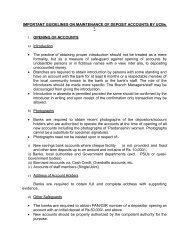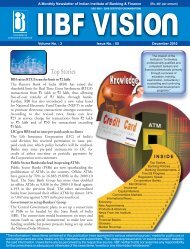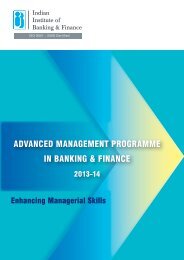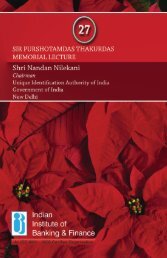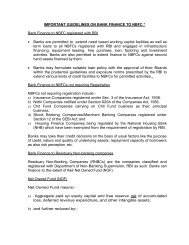Create successful ePaper yourself
Turn your PDF publications into a flip-book with our unique Google optimized e-Paper software.
special featureshould be continuous and consistent. How muchever expenses the organization spends on products,interior or design, adds meaning only when thecustomers feel comfortable with the organization.This comfort can only be arrived by constant andrelentless customer service.It would be apt to conclude with the quote given byMahatma Gandhi which describes the best practice oncustomer service. “A customer is the most importantvisitor on our premises. He is not dependent on us. Weare dependent on him. He is not an interruption in ourwork. He is the purpose of it. He is not an outsider in ourbusiness. He is part of it. We are not doing him a favor byserving him. He is doing us a favour by giving us anopportunity to do so.”Sources* Turban, Efraim (2002). Electronic Commerce : A ManagerialPerspective. Prentice Hall. ISBN 0131854615Asset Liability Mismatches (ALM) in the Indian Banking Sector : The Extent and Persistence** RBI press release dated Apr 26 2011. See also website(http://www.rbi.org.in/scripts/BS_PressReleaseDisplay.aspx?prid=24300)The analysis of the maturity profile of long-term assets andliabilities indicates that at the aggregate level, the long-termassets are financed by short-term liabilities. The ALM calculatedas long-term assets minus long-term liabilities never turned outto be negative during the recent years implying that the highergrowth observed in the long-term loan segment is leading to assetliability mismatches in the banking sector. Bucket-wise break-upof ALM positive gap shows that the banking sector has the highestALM positive gap in the bucket more than five years followed by3 - 5 years and 1 - 3 years. As at end-September 2010, ALMpositive gap in the more than five years bucket constituted 42per cent of the total ALM positive gap, followed by 3 - 5 years bucket(31 per cent) and 1 - 3 years bucket (27 per cent).An analysis of persistence of the positive ALM gap is carriedout following the methodology developed by Marques (2004).Accordingly, the persistence of ALM positive gap is estimatedon the basis of absence of mean reversion, that isγ= 1 -n_T )Where n stands for the number of times the series crossesthe mean during a time interval with T + l observations. It istheoretically proved that for a symmetric zero mean whitenoise process E (γ) = 0.5. Thus, if the value of γis close to0.5, it means that there is no significant persistence. Onthe other hand, if the value of γis significantly above 0.5 itsignals the existence of significant persistence. Under theassumption of a symmetric white noise process (zeropersistence), the statistic][γ-0.5 ________ 0.5 ∩N (0;1) Tis used for testing the statistical significance of the measure ofpersistence γ.)b Acceptance of the null hypothesis of zero persistence at 5 per centlevel.Note : Number of Observations used for the analysis is 55.The value of y for the ALM positive gap during the entiresample period, i.e., March 2006 to September 2010 for allSCBs is 0.47, which is slightly lower than 0.5. This indicatesthat there is no significant persistence in the ALM positivegap during the period under study at the aggregate level.The bucket-wise analysis of persistence shows that in noneof the time buckets, the persistence is significant at five percent level. However, at ten per cent level, it is persistent in the'one to three years' time bucket. Thus, in sum, though at theaggregate level, the ALM positive gap is not significant, in the'one to three years' bucket it is significant and calls for carefulmonitoring (Table).Reference :Table : Measure of Persistence ofALM Positive Gap - Bucket-wiseTime Buckets Persistence (γ) Significance(y-0.5) / (0.5 / T)bOne to Three Years 0.60 1.483 (0.0606)bThree to Five Years 0.47 -0.404 (0.3264)bMore than Five Years 0.47 -0.404 (0.3264)bTotal 0.47 0.405 (0.3264)Marques, Carlos Robalo (2004), 'Inflation Persistence : Factsor Artefacts?', Working Paper No. 371, June, European CentralBank.Source : Report on Trend & Progress of banking in India, 2010-11, RBI42October - December 2011The Journal of Indian Institute of Banking & Finance


